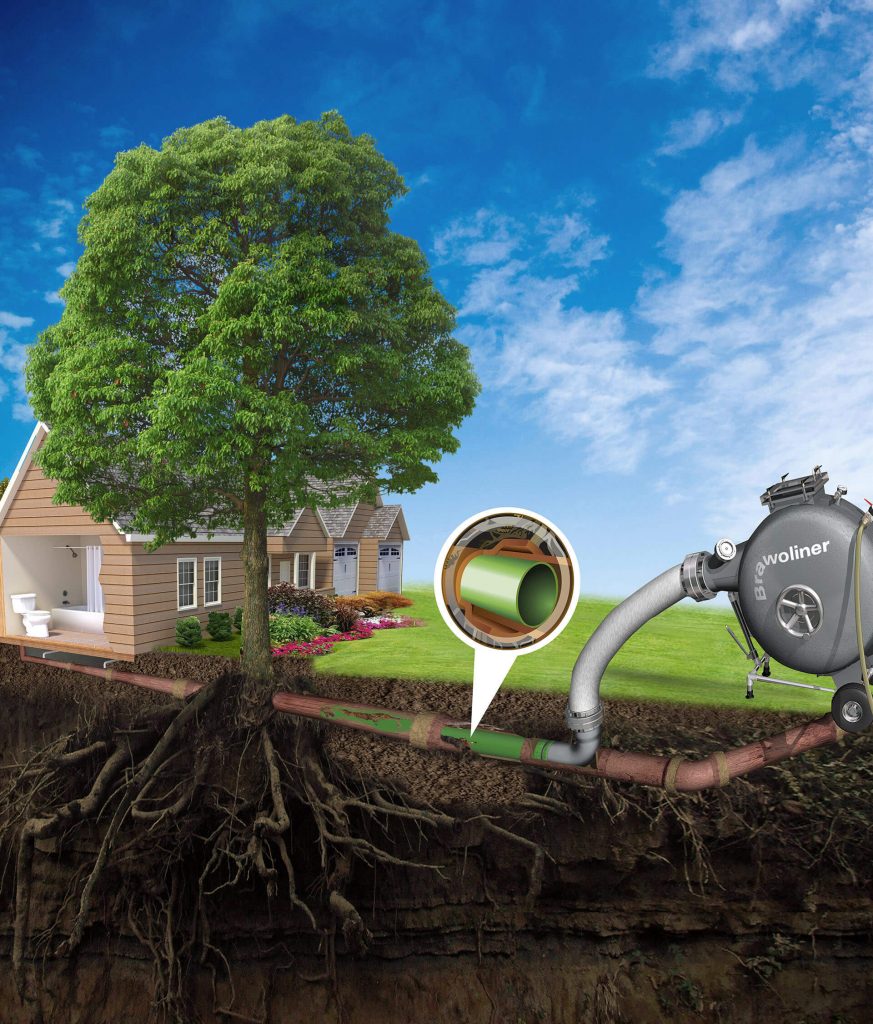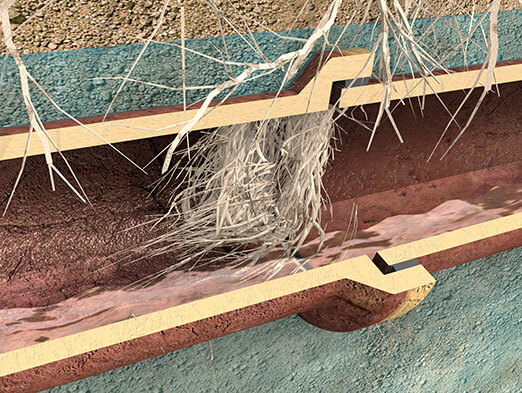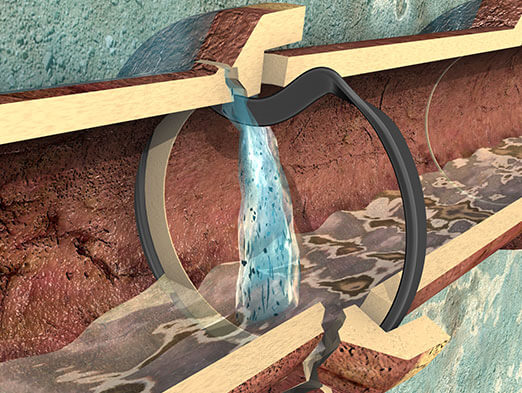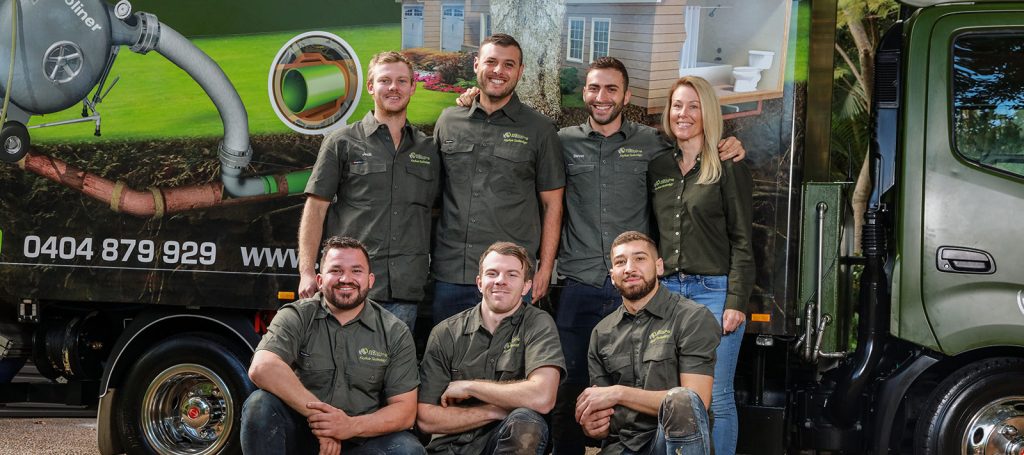The #1 best way to deal with tree roots in your sewer pipes is to call an expert pipe relining company. Digging up the tree roots yourself is very rarely advisable. Not only is it dangerous and damaging to work on your pipes without expert knowledge but in many cases, it is illegal.
Continue reading to learn why it can be dangerous to let these roots continue to grow without removing them from your underground pipes..
Tree roots are notorious for blocking sewer pipes…

Immovable, thick, and strong; if a tree root finds its way into your sewer pipe through a crack, or even if it’s strong enough to penetrate the pipe on its own, your plumbing could be in a world of trouble.
A tree’s root system will seek nutrients and water to support its survival, and a sewer pipe is a perfect source.
Particularly in dryer parts of the country, trees seem to be genetically programmed to find water, nutrients, and oxygen no matter the cost.
Drawn like magnets to house foundations, pools, and pipes, tree roots can leave a homeowner cursing at nature rather than marvelling at its ingenuity.

The danger of blocked sewage pipes…
Tree roots can be finite, as thin as a hair, meaning even the most minor cracks can allow access to the pipe. Once inside, tree roots can grow into a thick mass, blocking the pipes and resulting in messy and damaging sewage overflows.
When a sewage line is blocked, the sewage can back up and reappear in your laundry, bathroom, kitchen, or public spaces such as waterways, parks, and footpaths.
In some cases, tree roots can wrap around the pipe completely, causing them to collapse.
Trees are essential to our environment, health, wildlife, and comfort. With new developments popping up all the time across Sydney, the process generally involves piping first and landscaping last, prioritising what looks nice to attract potential buyers over what will work for the homeowner a few years down the line.
Nobody could blame house-proud gardeners for adding fruit trees and plants to improve their street side appeal; however, by knowing the ins and outs of the piping system, they could be saving themselves a world of stress, money, and effort down the line.
With trees built close to homes and foundations, underground pipes can be put under pressure and placed at risk of blockages and cracks. While sometimes it is not possible or advisable to remove old trees, care should be taken when planting new ones.
Some trees and plants have vigorous root systems that can cause sewer blockages and overflows if they’re planted too close to pipes. Some trees are more ‘pipe friendly’ than others.
How to avoid tree roots in your sewer pipes…

Discourage tree roots from entering your pipes with these helpful tips:
- Plant trees and shrubs strategically
Although root systems vary with every tree, the average root system will extend at about 1.5 metres the height of the tree, so plan your tree’s location accordingly. If you’re lucky enough to be starting from scratch with your landscape, acquire a map of your sewer lines from your plumber or builder so you can design your landscape strategically.
- Choose pipe friendly trees and plants
With the above information in mind while planning your landscape, you should aim to plant large trees as far from your pipes as possible, and if you need to plant near your pipes, select slow-growing species with a small root ball.
Check out our blog on the best trees to plant near your pipes.
- Install a physical root barrier
As you plant your new trees or browse the selection at Bunnings, consider installing physical barriers to redirect the roots away from your plumbing. These typically come in two types: solid barriers made from fibreglass or plastic and permeable barriers made from mesh screens to allow water through while blocking large root systems.
- Repair cracks as soon as they appear
Perhaps you suspect you have a cracked pipe based on one of these seven symptoms, or you have a suspiciously thriving large tree dangerously close to your pipes.
Call out a professional pipe service provider to look at your sewer main. If they notice a crack, there’s no time to lose. Getting those small cracks dealt with quickly will go a long way in preventing root systems from making a home within your pipes.
The best way to deal with tree root penetration…

As mentioned in the intro to this post, the best way to deal with pesky tree roots, is to hire pipe relining experts that understand how to fix this problem with a non-invasive process.
Furthermore, without a comprehensive knowledge of your pipe system or how sewer pipes work, you could be causing more harm than good. Nobody wants to be responsible for making their family use a public bathroom and spending their weekend digging up a chunk of pipe, only to realise it isn’t even the root infected section.
Watch below to see how pipe relining professionals can save a sewer drain without the hassle of digging trenches:
But wait…How can a sewer drain be fixed without all the extra digging?
When you call on the professionals, you will have the essential benefit of CCTV inspection and a trained eye, so you’re not spending more money or time than necessary.
Your plumber can inspect every junction and bend of your pipes so you can have clear evidence of what is causing the blockage and how to gain the best access point.
From here, your professional can perform pipe relining to cover any cracks or damage to prevent those pesky roots from finding an access point ever again.
With an epoxy liner coated in impenetrable resin (think dental fillings and railroad tracks), pipe relining is the solution for creating a new pipe within the old one, preventing the need for digging and trenching or weekends spent covered in mud.
In addition, after your pipe relining, your pipes will be completely resistant to tree roots for up to 50 years, meaning your sewer pipes are ready for action and no longer vulnerable to nature’s ingenuity.

Got a tree root problem?
The Relining Company is here to help you. With over 20 years of experience dealing with sewer pipes just like yours, we’d love to chat more about your particular problem.
Get in touch with our team today, and we can be on-site for your free consultation as quickly as a tree root searching for water.
Back to Top